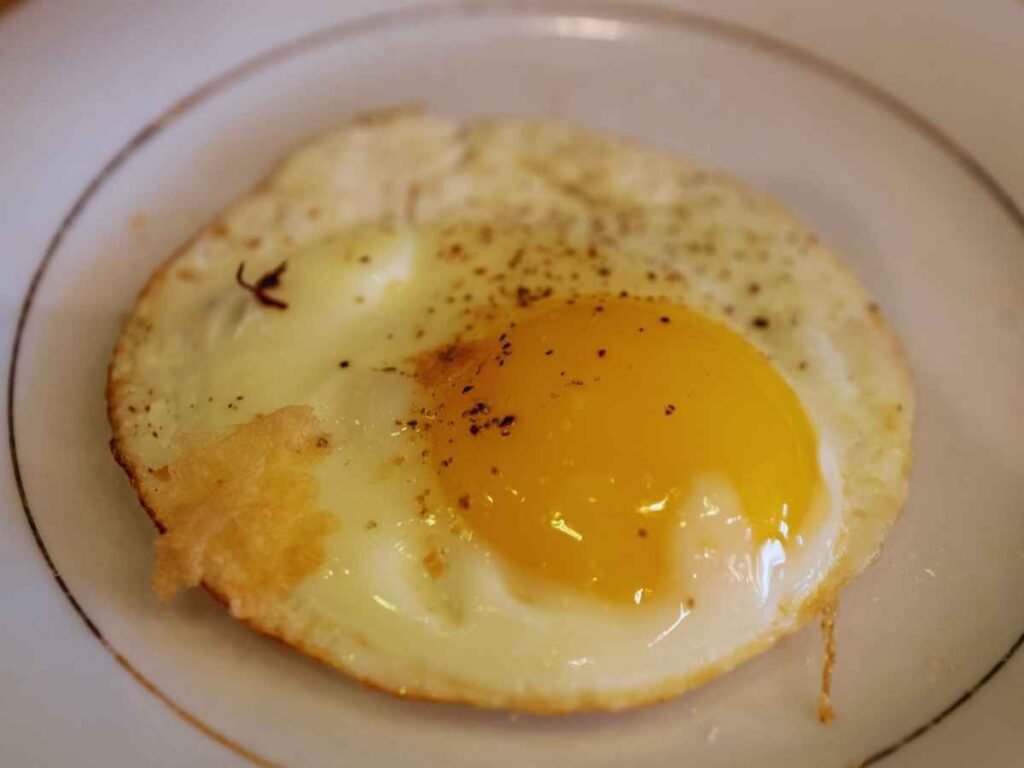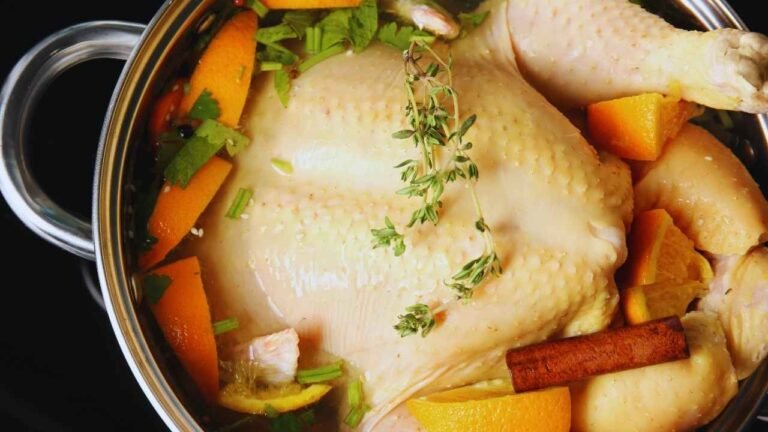How to Make an Over Easy Egg: A Step-by-Step Guide
Perfect over easy eggs need skill and practice. Many home cooks find it hard to get that sweet spot between cooked whites and runny yolks. The right technique can raise your breakfast game and add a chef’s touch to meals of all types.
This complete guide shows you the steps, tools and methods you need for perfect results every time. You will master temperature control and learn the right way to flip eggs. The guide has serving ideas and solutions to common problems that help you succeed in the kitchen.
What is an Over Easy Egg?

Over easy eggs get their name from a unique cooking method. The cook flips the egg and cooks both sides until the whites set completely. The runny yolk remains the key characteristic of this style. The cooking term breaks down simply – “over” describes the flipping motion and “easy” tells you how runny the yolk should be.
Definition
Learning how to make an over easy egg requires a significant understanding of the technique. The process involves cooking the egg on one side until the whites set almost completely. A careful flip allows brief cooking on the other side. This method creates a thin, pale layer over the yolk that keeps its liquid consistency. Over easy eggs need precise timing and temperature control to achieve the perfect balance between cooked whites and runny yolk.
Difference from other egg styles
Each egg cooking style differs from others in unique ways:
Egg Style Characteristics Cooking Method Over Easy Runny yolk, fully cooked whites Flipped, briefly cooked on second side Sunny-Side Up Runny yolk, never flipped Cooked on one side only Over Medium Slightly runny to jammy yolk Flipped, longer cooking time Over Hard Fully solid yolk Flipped, extended cooking time The biggest difference between an over easy egg recipe and sunny-side up comes from their cooking methods. Sunny-side up eggs stay unflipped throughout cooking. Over easy eggs need a quick flip that creates a thin film over the yolk. Both styles require completely set whites, but over easy eggs contain the yolk better. This makes them perfect for sandwiches where you want to control the mess.
Ingredients and Equipment

Success in making the perfect over easy egg requires gathering the right ingredients and equipment. The proper components play a significant role to achieve that ideal combination of set whites and runny yolk.
Eggs
Large or extra-large eggs work best in recipes. Their size gives you better control while cooking and lets the whites set perfectly without overcooking the yolk. Fresh, high-quality eggs hold their shape better and have stronger protein structures in the whites.
Butter or oil
Your choice of cooking fat substantially affects the final dish. These options work best:
Cooking Fat Benefits Butter Provides rich flavor and slower cooking Ghee High smoke point and rich taste Avocado oil Neutral flavor, high heat tolerance Olive oil Healthy option with distinct taste Non-stick pan
A quality non-stick pan is a vital part of making over easy eggs. Several options exist in the market, but a standard non-stick skillet gives you the most reliable results. The pan needs to meet these requirements:
- Clean and free from scratches
- Right size (8-10 inches fits 1-2 eggs perfectly)
- Proper heat level before cooking
Spatula
Your perfect flip depends on the spatula you choose. A thin, wide spatula makes all the difference. The right spatula needs:
- The flexibility to match your pan’s curves
- Enough width to hold the egg completely
- A thin edge that glides under the egg smoothly
- Materials that can handle high heat
Most professional chefs swear by metal fish spatulas or specialized egg turners that give the best results. A thin silicone or plastic spatula works great with non-stick cookware and protects the pan’s coating without sacrificing control during the flip.
Step-by-Step Instructions

The perfect over easy egg requires precise timing and attention to detail. A consistent result will come naturally when you follow specific steps.
Preheating the pan
Start your cooking with the right temperature. Place your pan on medium-low heat (around 2.5-3 on a scale of 1-10) and let it warm up for about 2 minutes. Drop a tablespoon of butter and let it spread across the pan’s surface.
Cracking and adding the egg
The butter will start to foam, signaling the perfect moment for your egg. Break the egg on a flat surface and let it slide into the pan. Your goal is to keep the yolk intact as the white spreads across the pan. Add a pinch of salt to season the egg at this stage.
Cooking the first side
These visual signs will appear during the original cooking phase:
- The whites start to turn opaque from the edges
- The area surrounding the yolk stays slightly translucent
- The white becomes firm and fully set after about 1.5-2 minutes
Flipping technique
Making an over easy egg requires significant attention during the final step. The perfect moment arrives at the time the whites are nearly set. The spatula should slide gently underneath and stay centered beneath the yolk. A quick yet careful flip completes the motion smoothly. Pro tip: The egg’s readiness can be tested by sliding the spatula under its edges without moving it.
Cooking the second side
The second side requires precise timing to achieve perfect results. These steps create an ideal over-easy egg:
- Cook the egg just 30 seconds more
- Switch off the heat right away
- Let the remaining heat complete the cooking process
Your egg whites should set completely while the yolk stays liquid. The final step needs a gentle touch – slide the egg carefully onto your plate without breaking the yolk.
Tips for Perfect Over Easy Eggs

Becoming skilled at cooking over easy eggs depends on attention to detail and proper techniques. These tips will help you raise a simple egg preparation to restaurant-quality results.
Choosing fresh eggs
Fresh eggs play a significant role in creating the perfect over easy egg. A simple water test helps determine an egg’s freshness. Place the egg in a bowl of water and observe its position. Fresh eggs sink and lay flat on the bottom, while older eggs float or stand upright. Fresh eggs maintain their shape better during cooking and create an attractive presentation that makes flipping easier.
Temperature control
Temperature management creates the perfect over easy egg. Here’s everything in getting it right:
- Keep the heat at medium-low while cooking
- The pan needs proper preheating before butter goes in
- Quick cooking with high heat won’t work
- Butter’s foaming tells you the temperature is just right
Timing
Perfect timing can revolutionize a good over easy egg. The process relies on specific visual indicators:
Stage Visual Cue Timing Original cook Whites turn opaque 1-2 minutes Pre-flip Whites almost set Only ½ inch around yolk is translucent Second side Quick sear 30 seconds maximum Flipping without breaking the yolk
Making an over easy egg requires mastery of the flip – the trickiest part of the process. Your success depends on how you position the spatula, move with confidence, and time it right. The spatula should glide smoothly under the egg before you start. Place it right under the yolk, then lift and flip in one fluid motion.
Here’s a pro tip – crack your egg into a small bowl first and slide it into the pan. You’ll have better control this way and can pick out any pesky shell pieces. This simple step helps prevent the yolk from breaking, which often happens with direct pan cracking.
The best chefs suggest practicing your flipping motion with a slice of bread first. This helps build muscle memory without wasting eggs and gives you the confidence you need to nail those perfect flips.
Serving Suggestions
Over easy eggs create countless delicious meal options that match everyone’s tastes and priorities. Classic breakfast combinations and modern healthy dishes showcase how these versatile eggs turn simple ingredients into satisfying meals.
Toast and dipping
A over easy egg tastes best with buttered toast. Sourdough bread makes a perfect base that adds a delightful tangy crunch. Whole grain bread works as a heartier option. The egg’s golden yolk transforms into a natural, rich sauce that pairs perfectly with crispy toast points.
Breakfast sandwiches
A perfectly cooked over easy egg lifts any breakfast sandwich and the perfect combination has:
Component Suggested Options Bread English muffin, sourdough, croissant Protein Crispy bacon, ham, breakfast sausage Cheese Cheddar, pepper jack, American Avocado toast topping
Over easy eggs make an excellent modern breakfast companion to avocado toast. The creamy avocado creates perfect harmony with the runny yolk that results in a protein-packed meal. These popular additions elevate the dish:
- Everything bagel seasoning
- Cherry tomatoes or sliced tomatoes
- Fresh herbs or microgreens
- Hot sauce or red pepper flakes
Perfect timing matters when serving over easy eggs – each bite should be savored right away while the yolk stays perfectly runny and the whites remain tender and warm.
How to Make an Over Easy Egg: A Step-by-Step Guide
Course: BreakfastCuisine: AmericanDifficulty: Easy1
servings2
minutes3
minutes100
kcalPerfect over easy eggs with set whites and a runny yolk, cooked in just a few simple steps. Ideal for breakfast or as a topping for toast, sandwiches, or salads.
Ingredients
2 large eggs
1 tbsp butter (or cooking fat of choice)
Salt and pepper (optional)
Directions
- Heat a non-stick skillet over medium-low for 2 minutes.
- Add butter and let it melt until foamy.
- Crack eggs into a bowl, then slide into the pan.
- Cook for 1.5-2 minutes until whites set, and yolk stays runny.
- Flip gently and cook for 30 seconds.
- Turn off the heat and let residual heat finish cooking.
- Serve immediately.
Recipe Video
Notes
- Control heat and timing for a flawless flip. Cook on medium-low to avoid overcooking the yolk. Practice makes perfect, so don’t worry if your first flip isn’t ideal!
FAQs
What is the best method for cooking an over easy egg?
To cook an over easy egg, the key is to gently flip the egg during cooking to ensure both sides are evenly cooked without breaking the yolk.
How do you flip an over easy egg?
Yes, flipping is a crucial step in making over easy eggs. It allows both sides of the egg to cook evenly.
What distinguishes an over easy egg from a sunny side up egg?
A sunny side up egg is cooked on one side only, leaving the yolk runny and the white just set. An over easy egg, on the other hand, is flipped during cooking, which slightly cooks the yolk while ensuring the white is fully set.
Are over easy eggs considered healthy?
Yes, over easy eggs are healthy as they are lower in calories and saturated fats compared to other styles like fried or scrambled eggs. The whites are fully cooked, making them safe to consume.
How can you make an over easy egg without ruining it?
The key to a perfect over easy egg is to use a non-stick pan and a gentle touch when flipping the egg to avoid breaking the yolk. Proper heat management and timing are also crucial to achieve the desired doneness without overcooking.








